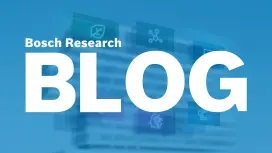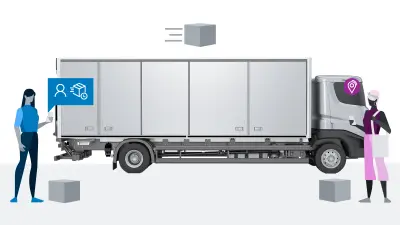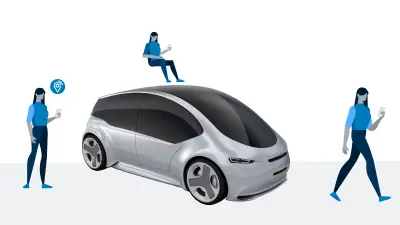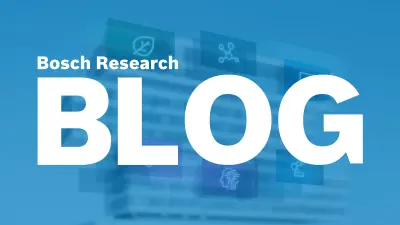Why reliable distributed systems are the next big thing
Bosch Research Blog | Post by Dirk Elias, 2021-11-03
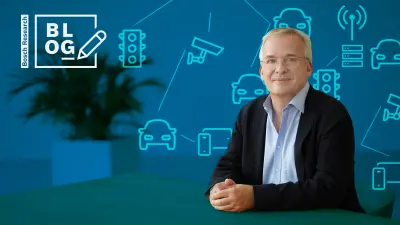
Just imagine the following 2030 scenario: The US government and the state of Arizona just approved the law for ‘infrastructure-assisted fully automated driving’. For Bosch and its partnering technology and mobile telecommunication companies as well as the metropolitan region of Phoenix, this paved the way for the official launch of the region-wide service ‘People, Parcel, Phoenix’ P³ (p-cube). P³ is a metropolitan area-wide, fully autonomous public transportation system for people and goods. For passengers, the system serves as an on-demand hop-on-hop-off system that picks you up where you are and transports you to where you want to go. Predictable but with a dynamic time and connection schedule. The system tells passengers when they will get picked up and guarantees a maximum ride time and number of hops: much more convenient than traditional bus systems, and at the same time significantly more economic and ecological.
The solution for express parcel delivery would also be an outstanding success. Customers specify where they want to send a parcel from and simply need to indicate the recipient and the maximum duration of the transport. The sender just hires a compartment in a delivery truck that can provide 50 individually bookable parcel compartments. The recipient can then use an app to specify where he or she would like to receive the parcel and can even book a ‘follow me’ service, in which the delivery takes place at the recipient’s real-time location at the time of delivery. As the parcel compartments not only offer different sizes, but also a temperature-controlled environment, transporting food or medicine is no problem. Last but not least, P³ also features passenger cars that will be used by the system as ‘robo-taxis’ for individual rides.
So far, so good. What would the officials say with regard to this project? Well, the 2030 mayor of Phoenix might say something like: “All of this is a huge step toward our objective of zero emissions and zero traffic fatalities in the Phoenix region. We refer to this as Vision Zero. As a convenient alternative to individual traffic, P³ not only reduces the city’s carbon footprint, but also increases the competitiveness of the local economy by providing much better logistics in the more distributed post-Covid work environment.”. And the 2030 Bosch project manager might add: “This project could be made a reality thanks to the latest generation of level 2 electric vehicles, such as delivery trucks, buses and cars, paired with the Bosch mobility management system “Perfect infrastructure-assisted mobility (PerfectIAM).”
So far for potential future news. But what does this have to do with a research blog from today?
The following is a description of a purely hypothetical product, PerfectIAM, which a company like Bosch might develop from a set of technologies on which we as researchers are currently working. Today we will introduce them by describing their contribution to the product. Further blogs will address the technologies in greater detail. Stay tuned!
Will this become a real product? – Perfect infrastructure-assisted mobility
As always, the most exciting things happen under the hood
A hypothetical product like PerfectIAM boosts the autonomy level of the delivery trucks, buses and cars from level 2+ to level 4 within infrastructure-equipped environments, like in the scenario described above. This could allow the operation of the vehicles without a driver, although the vehicles do not have fully autonomous compute & sensor technology on board. The result is not only a cost reduction per vehicle, but also a significant reduction of the on-board compute energy consumption by 1-2kW, thus increasing the operating range of the vehicles at a lower speed and in congested traffic conditions as typical for city traffic.
How does it work?
The hypothetical PerfectIAM solution would probably consist of three parts:
An economic, self-configuring and self-calibrating package of E/E components for vehicle manufacturers (OEMs).
The PerfectIAM distributed edge solution that runs on any edge cloud-compute platform, which conforms to a desirable GAIA-X standard for infrastructure-assisted autonomous driving.
A future traffic sensor solution, so-called roadside units (RSU), providing data, for example, from traffic cameras & radar sensors, tapping of traffic lights, which are connected to the edge cloud-compute platform via 5/6G.
The PerfectIAM distributed edge solution will allow significant amounts of the autonomous driving functionalities and the related hardware and software to be safely off-boarded from the vehicle into the edge compute and cloud platform.
Digital twins of locations
The core idea of PerfectIAM itself results from another “real” cooperation project of Bosch. In 2021, Bosch Research and the Carnegie Mellon University in Pittsburgh teamed up to make ‘spatial computing’ reliable and real time capable. This gives us the possibility to construct real-time-capable digital twins of locations, like a street intersection running on platforms such as the PerfectIAM edge cloud-compute solution. Hence, the digital twin hosts all observations and intentions of the vehicles relevant for the intersection, all information from the relevant RSUs, and the information of the system users (passengers, parcel receivers, etc.). Reliable spatial computing now allows all the knowledge of the digital twins to be used by functions that perform specific tasks, like trajectory planning, and the results to be made available to the community of digital twins in real time. So, the PerfectIAM digital twin model will be layered.
- It includes digital twins of all the users and vehicles, containing not only driving-relevant information, but also information with regard to the load (passengers and parcels) and the vehicle itself (maintenance, real-time and predictive diagnostics, etc.).
- The multitude of cars and users, together with the map, external information, such as weather forecasts and the observation from the RSU infrastructure, forms a digital twin of a crossing.
- The multitude of crossings and roads forms a digital twin of the city itself. Future extensions will allow for the integration of additional systems into the city’s digital twin, like the smart electricity grid, water supply, fire alarms, building information model, etc. A holistic real-time twin of a truly smart city!
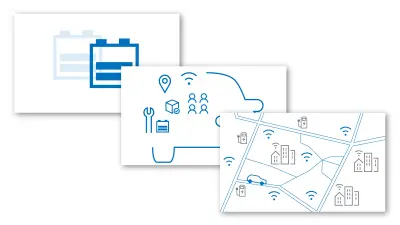
Based on the observations from the infrastructure and the various level 2+ vehicles, PerfectIAM is able to generate real-time models of the crossing by adding in the multitude of sensor systems available. The large number of cross-checked sensors and different viewpoints will provide a significantly higher degree of coverage than a system in a single car could ever provide. Thus, PerfectIAM outmatches a purely on-board level 4/5 system when it comes to holistic perception and thus safety! In combination with knowledge of the intentions of each PerfectIAM-managed vehicle, the system is capable of computing individual trajectories and transmitting them to the respective vehicles. All in real time and naturally with permanent monitoring of the overall situation as there are still a lot of traditional cars and, of course, pedestrians around.
Safe by design: Systems that consider unavailability and failure also as state of operation
As already indicated, such a system needs to be safe by design. PerfectIAM’s modern and cost-effective OpenRAN-based 5G network makes it possible to ensure that there is always more than one base station available along the route and all vehicles are equipped with dual 5G transceiver technology, which allows them to have two simultaneous connections. The 5G network management system ensures that those connections always use different base stations. Thus, the risk of a vehicle losing its connectivity completely is extremely low. And just in case, the fail-safety of the system is assured, either by performing the minimum risk maneuver permanently precalculated by the infrastructure in advance, or by the onboard level 2+ technology allowing the vehicles to safely stop on the side of the road. And if everything falls apart? Imagine a run-away balloon from the Albuquerque Balloon festival in the shape of an elephant stranded in the middle of a Phoenix road crossing. In case of unusual events that go beyond the AI-fueled decision capabilities of PerfectIAM, there is a 24/7 remote driver control center available. This could be useful in situations when the system performs emergency stops and a remote driver is needed to analyze the situation and safely steer the vehicle around the obstacle.
Is this all science fiction?
Not at all! And the underlying basis, RDS, is even domain-agnostic. This means that the same technology can be used also for I4.0 solutions or decentralized building automation. But, in any case, there are two questions that need to be answered: Is there a business model, in this case behind PerfectIAM, which makes it attractive for all stakeholders? And how long will it take to build it? The first question is one we naturally won’t discuss publicly in a research blog. The second question we would like to answer as follows: There is no black magic under the hood! All required technologies exist in labs around the world today. Just not for productive use and not integrated yet, but researchers are working on it. If you want to be part of the people making it happen, you should consider having a look at our TalentHub.
What are your thoughts on this topic?
Please feel free to share them or to contact me directly.
Author: Dirk Elias
Dirk Elias heads the Bosch Research division ‘Advanced Digital’, focusing on information and communication technologies, software development, as well as systems engineering and simulation. He is also responsible for the Bosch Research and Technology Center in India. Dirk, who graduated as an electrical engineer and holds a PhD in computer science, joined Bosch in 2017. Before that, he built Fraunhofer Portugal from scratch and headed it for 9 years. In 2000, he started IVISTAR AG in Berlin, a company that focused on IoT solutions for open offices and also supplied development services to Deutsche Telekom for the smart home sector.

